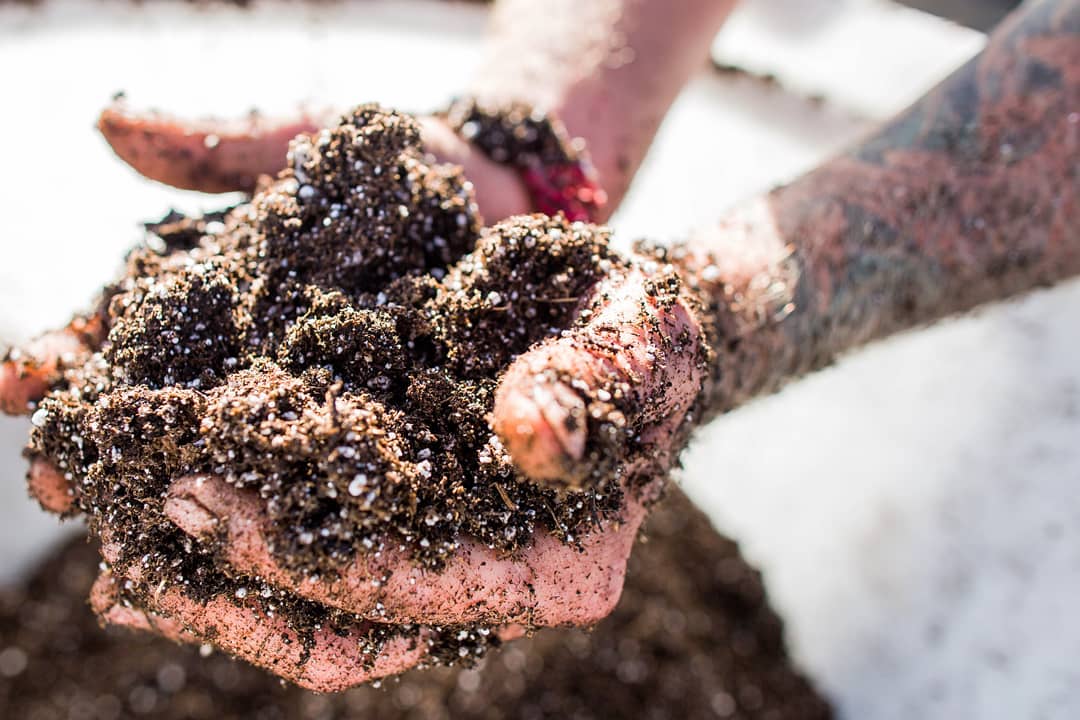“The garden is our oldest metaphor. In Genesis God creates the first Adam from the adamah, and tells him to “till and keep” it, the fertile soil on which all life depends. … That’s our first etymological clue as to the inextricable bond we share with the soil. … The command to care for soil is our first divinely appointed vocation, yet in our zeal to produce cheap, abundant food we have shunned it; we have tilled the adamah but we have not kept it.”
Fred Bahnson, Soil and Sacrament
At Coastal Roots Farm we practice the Jewish value of le’ovda u’lishmora—tending the land—in part by building up our soil.
Soil is the building block of life. For people to flourish, soil must flourish. As a living thing, soil has many of the same needs we do: oxygen, water, food. Soil is not just dirt—far from it! This miraculous and essential piece of growing food is an entire community of insects, microbes, microorganisms, worms, as well as organic matter and minerals from weathered rock.
As Fred Bahnson writes, “Soil is a living organism, or rather a collection of organisms, and it must be fed. Soil both craves life and wants to produce more life, even a hundredfold. … There is an entire ecosystem in a handful of soil: bacteria, fungi, protozoa, nematodes, earthworms. Through their breeding and dying such creatures vivify the world.”
Humus is the organic component of soil, formed by the decomposition of leaves and other plant material. Microorganisms feed on organic matter and break it down, which in turn becomes humus. Rich in minerals and nutrients, humus is the essential element to making plants grow. In a forest environment, this organic matter occurs naturally as trees and leaves break down (one of the reasons our food forest is designed to imitate a naturally-occurring forest environment!).
The soil on the Farm is sandy, and we use a number of techniques to build up the organic matter (humus) in order to create a richer topsoil for our crops to thrive in. One of the ways we do this is mulching. Adding organic matter like woodchips on top of soil serves as a protective coat for the roots and organic matter beneath. It locks in moisture and nutrients so that the soil below is free to nourish roots without disturbance.
We also plant cover crops, which serve a similar purpose. These crops protect fallow (unused) soil from sun damage and hold it in place, reducing runoff. Cover crops encourage root growth by fixing nitrogen. We recently planted pasture—a mix of clover, alfalfa, flax, and buckwheat—that will serve the dual purpose of protecting soil and feeding our chickens!
We’ve written about our compost operations before, and you can check out this blog post to catch up to speed. Adding compost to our soil is the primary way we build up a richer, more alive soil at the Farm.
COMPOST PROCESS:
We convert waste from another Leichtag Commons tenant, GoGreen, and waste of local tree trimmings into compost, which we then integrate into our soil. We integrate through compost tea and by adding compost to veggie beds. After we harvest a crop we clear the bed, spread the compost, and then incorporate using some lower-impact tillage. Soil requires oxygen so to keep airflow, we avoid using heavy machinery to crush it down.
We are moving toward low-tillage because it lets the organic matter near the roots do its work. It allows the networks of fungal webs spread instead of breaking this network of bacteria, fungi, and microorganisms. The community of microorganisms is disrupted every time you till. These biological processes are disrupted every time you mess with the soil. “Biology is a huge component of functioning soil.”- Ellie
When you talk about soil structure, biology is a huge component in creating the glue that holds soil together. By not disturbing it, you let biology do its work.
That’s why we add low-impact and all-organic fertilizers. There are so many nutrients in the soil that aren’t plant accessible and need biology to be able to access it. If we destroy the ecosystem, they’re (microorganisms, microbes, fungi, etc.) not there to process nutrients and convert decomposing organic matter into rich soil.
To date, we’ve produced over 2.5 million pounds of compost from green waste, food scraps, and tree trimmings, and last quarter alone produced 146,015 pounds. This compost gets incorporated into the soil to boost organic matter and encourage the growth of beneficial fungi and microorganisms, creating rich soil for healthy plants.
